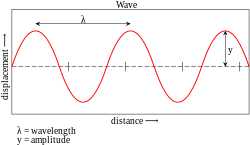Amplitude
| | Subject classification: this is a physics resource . |
The amplitude or peak amplitude of a wave or vibration is a measure of deviation from its central value. Amplitudes are always positive numbers (for example: 3.5, 1, 120) and are never negative (for example: -3.5, -1, -120). Amplitudes are positive because distance can only be greater than zero or equal to zero; negative distance does not exist.

In this picture, y is the amplitude of the wave
The distance from the top of one peak to the bottom of another is called peak-to-peak amplitude. Another way to describe peak-to-peak amplitude is to say that it is the distance between the maximum positive value and the maximum negative value of a wave.
Vertical distribution of the deep water waves amplitudes is shown below:

| | Look up Amplitude in Wiktionary, the free dictionary. |
| |||||||
This article is issued from Wikiversity - version of the Saturday, December 06, 2014. The text is available under the Creative Commons Attribution/Share Alike but additional terms may apply for the media files.